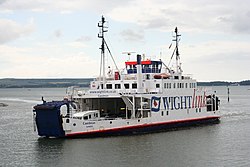Wightlink C class
|
Caedmon
|
||||||||||||
|
||||||||||||
|
||||||||||||
|
||||||||||||
|
||||||||||||
The C-Class was a class of three double-ended ferries operated by the British shipping company Wightlink. The ships mainly operated on the route between Lymington and Yarmouth on the Isle of Wight .
history
The ships were built in 1973 for the British Railways Board at the Robb Caledon Shipbuilders yard in Dundee . The design was based on the Cuthred , built in 1969 , which, like the three C-class ferries from Sealink, was used in ferry traffic to the Isle of Wight. The first-built Caedmon , named after the late 7th century English poet , started moving on the route between Portsmouth and Fishbourne. It operated here until 1983, before it was relocated to the route between Lymington and Yarmouth after the commissioning of the first two Saint-class ferries . The other two ferries, the Cenwulf , named after a king of the Anglo-Saxon Kingdom of Mercia , and the Cenred , also named after a king of Mercia , operated on the route between Lymington and Yarmouth from the start.
From 1990 the ferries were operated by the company Wightlink, which was founded by Sea Containers after the sale of Sealink British Ferries.
All three ferries were replaced by Wight-class ferries in 2009 . They were first in Marchwood launched and 2010 to the demolition company Smedegaarden in Esbjerg sold, where they were scrapped.
Technical data and equipment
The ships were of two four-stroke - six-cylinder - diesel engines of the manufacturer Mirrlees Blackstone driven in Stamford, the two -Schneider Propeller Voith worked, each of which was installed at one end of the ferries to the side.
On the main deck there was a continuous vehicle deck with three lanes. On the sides, further cars could be transported in front of and behind the side deck superstructures . 110 gauge meters were available for trucks on the main deck. The vehicle deck was accessible at both ends via fold-down ramps. In the middle area it was covered by the superstructures. Here there were lounges for the passengers and open deck areas. The bridge was placed in the middle of the superstructure . Below the main deck there were two engine rooms , each with one of the two drives. In between there were lounges with seating for the passengers.
To increase the passenger car capacity, all three ships of the 1977 class were equipped with an additional, height-adjustable vehicle deck with three lanes, which was accessible via movable ramps and which could be divided to increase flexibility, so that there was also a lane with sufficient usable height for transport of trucks was present. If the height-adjustable vehicle deck was not used, it was on the main deck. Vehicles with a maximum height of 4.15 meters could then be transported.
A total of 722 m² was available on each of the ferries: 467 m² on the main deck and 255 m² on the height-adjustable deck.
Ships
| C class | ||||
|---|---|---|---|---|
| Building name | Build number | IMO number |
Launched delivery |
Whereabouts |
| Caedmon | 560 | 7314888 | 3rd May 1973 July 1973 |
Scrapped in Esbjerg in 2010 |
| Cenwulf | 561 | 7320021 | June 1st 1973 August 1973 |
Scrapped in Esbjerg in 2010 |
| Cenred | 562 | 7324091 | 3rd July 1973 September 1973 |
Scrapped in Esbjerg in 2010 |
The ships sailed under the flag of the United Kingdom . Home port was London .
Web links
- Private website with numerous photos of the ships
- GA map (JPG, 143 kB)
Individual evidence
- ^ Caedmon ( Memento of September 23, 2008 in the Internet Archive ), Wightlink.
- ^ Cenwulf ( Memento of September 23, 2008 in the Internet Archive ), Wightlink.
- ^ Cenred ( Memento September 23, 2008 in the Internet Archive ), Wightlink
- ^ History ( Memento of February 21, 2009 in the Internet Archive ), Wightlink.
- ^ Wightlink's "C" Class Vessels Caedmon, Cenred & Cenwulf laid up at Marchwood , April 7, 2009. Accessed July 13, 2020.
- ↑ a b plan of the ferries (JPG, 143 kB). Retrieved July 13, 2020.
- ↑ Comparison between old and new ferries ( Memento of April 22, 2008 in the Internet Archive ), Wightlink.
- ↑ a b An Analysis of Lymington-Yarmouth Ferry Capacity , Version 2.1a, June 13, 2008, The Lymington River Association (PDF, 3.3 MB). Retrieved July 13, 2020.
- ^ Caedmon , Scottish Built Ships - The History of Shipbuilding in Scotland, Caledonian Maritime Research Trust. Retrieved July 13, 2020.
- ^ Cenwulf , Scottish Built Ships - The History of Shipbuilding in Scotland, Caledonian Maritime Research Trust. Retrieved July 13, 2020.
- ^ Cenred , Scottish Built Ships - The History of Shipbuilding in Scotland, Caledonian Maritime Research Trust. Retrieved July 13, 2020.
